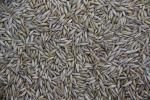H2020 EUCLEG Project: Improvement of forage and grain legumes to increase protein self-sufficiency in the EU and China
- Type Project
- Status Filled
- Execution 2017 -2021
- Assigned Budget 5.000.000,00 €
- Scope Europeo
- Main source of financing Horizon 2020
- Project website Proyecto EUCLEG
An impressive amount of genotype and phenotype data has been collected from hundreds of legume accessions as part of the EU-funded EUCLEG project. The description of genetic diversity, markers associated with trait variation, and genomic prediction equations are results that open up new opportunities to advance legume genetic improvement.
Training in statistics and molecular breeding has been offered, both within and outside of EUCLEG, to share these promising results, in addition to publications and conference papers. Breeders from public institutes or private companies can now use this knowledge to optimize genetic diversity and implement marker-assisted breeding. All this progress, in turn, will lead to strategies for faster genetic improvement of new varieties that will help boost the use of legumes in livestock and agriculture in Europe and China and reduce protein dependence, thus contributing to the overall objectives of the project.
Genotype data have been generated:
- Alfalfa - Europe: 1061 accessions were genotyped by GBS. Allele frequencies for 228K SNPs were missing, with less than 5% missing data, and 118K SNPs were missing. China: 220 individuals were genotyped using whole-genome sequencing (560K SNPs).
- Red clover: 641 accessions were genotyped by GBS. Allele frequency data for 65,000 SNP markers were obtained.
- Broad bean: 400 accessions were genotyped with a 50K Axiom array. Genotype data were collected for 35K markers.
- Pea: 260 accessions were genotyped using the 13K GenoPea array. Genotype data for 12K markers.
- Soybean: 479 European and 326 Chinese accessions were genotyped using the 355K SoySNP array. Plant genetic resource inventories for the five target species in Europe and China were compiled, and the gaps between the EURISCO system and the European Central Crop Databases were narrowed.
Reports were prepared to describe the challenges and risks associated with the exchange of plant genetic resources, China's plant variety protection system, and its relevance to European breeders. Thirty-four field experiments were conducted in Europe and China with hundreds of accessions, and traits related to yield, quality, and stress resistance were measured. In addition, experiments were conducted under controlled conditions to evaluate traits related to biotic and abiotic stress, and seedling vigor.
A central infrastructure for project data management was established in the Progeno system, where partners imported genotype and phenotype data. Enormous phenotypic and genetic diversity was revealed across the five species. Because many markers were used, the genetic structure was added to current knowledge. For example, in alfalfa, diversity in China and the EU-America is largely different, and within the EU-America diversity, there is a range of diversity partly related to the geographic origin of the varieties.
In soybean, a genome-wide genetic diversity scan revealed multiple signatures of selection in a European soybean collection compared to Chinese collections of wild and cultivated soybean accessions. Genotype x environment interactions were generally significant, but high-yielding accessions and/or accessions carrying positive traits were identified. A GWAS was performed and revealed lists of QTL for nearly all traits in all five species. An analysis of genome annotation at QTL regions provided lists of potential candidate genes whose sequence diversity can explain phenotypic variation.
The routines needed to implement genome prediction have been developed, and EUCLEG members have been trained. The genome predictions were more accurate than in most previously published studies, probably due to the use of a large number of accessions and numerous markers. The standard genome prediction was often better than 0.5, while the addition of QTL to the genome prediction equations raised the predictive power to 0.8. In Work Package 6 (WP6), a collaborative website was established to share project results, and newsletters were developed and distributed. The results have been presented at various scientific conferences, and several articles have been published in peer-reviewed journals; others are in preparation.
EUCLEG aimed to provide tools and knowledge to improve the genetic progress of five major legume species: two forage crops, alfalfa and red clover, and three grain legumes, pea, faba bean, and soybean. This involved genotyping, phenotyping, and statistical work. In WP1, we developed molecular and genomic tools. For the two outbred forage crops, we used genotyping by sequencing (GBS) to obtain marker frequencies from pooled individuals within each accession (pool-GBS). For the three self-pollinated grain legumes, we used SNP array technology to genotype the accessions. In WP2, we structured and improved access to data from European and Chinese plant genetic resource collections. We identified gaps (both passport and phenotypic data) in existing information systems and encouraged collection holders to address them. We created an efficient infrastructure for the centralized management of data collected during the project (the Progeno database).
Finally, the legal challenges and risks associated with the sharing of plant genetic resources and their data, as well as intellectual property issues, were considered. In Work Package 3 (WP3), the genetic structure of germplasm collections was described using phenotypic traits and molecular markers. Trials were established in a network of environments in the EU and China. Relevant phenotypic traits were assessed: germination, crop establishment, response to biotic and abiotic stresses, forage and seed yield, and forage and grain quality. A description of Chinese and European germplasm was provided, as well as an overview of genotype x environment interactions, and promising germplasm was identified. The genetic structure of the germplasm was described using genotype data obtained in work package 1. In work package 4, genes, alleles and molecular markers were identified that explained much of the phenotypic variation available for traits involved in crop yield and stability, including resistance to biotic and abiotic stresses.
The Work Package 2 database, which contains genotype and phenotype data, was used for genome-wide association analyses (GWAS). WP5 provided breeders with knowledge and tools to implement genomic selection, a form of marker-assisted selection that, in many cases, is more efficient than phenotypic selection. An intuitive tool was developed for data management and the calculation of breeding values (BV) and genomic breeding values (GBV). The effects of various determinants on the accuracy of the GBV prediction equation were evaluated, and breeding solutions, including genomic selection, were proposed. WP6 disseminated the project results to the scientific community and transferred the innovations to stakeholders.
EUCLEG aims to reduce Europe and China's dependence on protein imports by developing efficient breeding strategies for legume crops of major economic importance in human and animal feed. The goal is to improve the diversification, crop productivity, yield stability, and protein quality of forage legumes (alfalfa and red clover) and grain legumes (peas, broad beans, and soybeans).
Using diverse and extensive genetic resources and advanced molecular tools, EUCLEG aims to identify and develop the best genetic resources, phenotyping methods, and molecular tools to breed legume varieties with improved performance under biotic and abiotic stresses in representative agroecological zones of Europe and China. The potential for new uses of forage species for human nutrition will be explored.
Searchable databases will be developed or built to house passport, agronomic, and genetic data to facilitate the exchange and use of genetic resources. The evaluation of genetic resources in multi-site trials will allow for the expansion of breeding material and the expansion of agroecological adaptation. The genetic architecture of key genetic traits will be analyzed through association studies to identify molecular markers related to phenotypic traits.
Finally, genomic selection strategies will be evaluated for their potential to improve genetic progress. Breeders will be provided with practical tools for genotyping, data management, and computation to implement marker-assisted selection and genomic selection leading to the creation of new varieties in the long term. The partnership brought together in EUCLEG, which combines public institutes and private companies from Europe and China, ensures the transfer of knowledge from research to the seed industry.
An EU-funded project is helping Europe and China increase their level of protein self-sufficiency. Pulses are an important part of food and feed production and have a positive impact on the environment. Rich in protein, they contribute to the input of nitrogen into cropping systems, potentially reducing the need for synthetic nitrogen fertilizers. They also offer a nutritious plant-based alternative to meat—a growing market, with many looking for new ways to harness the potential of plant-based protein production. As such, there are many reasons to grow more pulses. However, in Europe and China, areas with appropriate agro-ecological conditions for growing plant protein, there is a deficiency, as both continents rely heavily on protein imports and heavy use of synthetic nitrogen fertilizers. The EU-funded EUCLEG (Breeding Forage and Grain Pulses to Increase EU and China Protein Self-Sufficiency) project is helping to reduce this dependency. "We're working on legume crops, with the ultimate goal of improving varieties," says Bernadette Julier, project coordinator and research director at INRAE, the French National Research Institute for Agriculture, Food, and the Environment. This involved genotyping, phenotyping, and statistical work.
Improving Genetic Progress EUCLEG focused on the five most widely cultivated legume species in Europe: two forage legumes, alfalfa and red clover, and three grain legumes, pea, broad bean, and soybean. “Our objectives were to help plant breeders create better-adapted, higher-yielding varieties. These legume varieties will be grown in geographical areas where legumes are already grown and will offer higher yield, quality, and stability than current varieties, or they will contribute to expanding the crop area in regions where legume cultivation is scarce,” explains Julier. Higher yields and larger crop areas will contribute to the production of more local protein; the new varieties will be more easily introduced into crop rotations for diversification.
The project's work has led to the publication or adoption of genomic genotyping tools for the five major legume species. "We have also gained new insight into the genetic diversity available for plant breeding within each species. The large number of markers obtained across a broad set of accessions has clearly renewed knowledge about alfalfa and soybean. New sources of phenotypic variation have also been identified," adds Julier. Thanks to genomic genotyping, the project was able to identify molecular markers associated with trait variation. These markers could be used in breeding programs to accelerate genetic progress. "Furthermore, the predictive power of the main traits has been calculated, and the results suggest that genomic selection should also accelerate genetic progress in legume breeding, as it has in other important plant and animal species," says Julier.
Increasing Ambition Several legume breeders, both public and private, contributed to data collection and analysis. “This collaboration favors the transfer of knowledge from research to industry,” Julier notes. During the project, training sessions for breeders were also organized. “They have seen the anticipated potential of molecular breeding in legumes. In the long term, I hope that legume breeding will use molecular tools to accelerate genetic progress and release varieties adapted to different constraints and uses,” he adds. Regarding the next steps, the project aims to demonstrate the progress that can be achieved with molecular breeding compared to phenotypic breeding. “In parallel, it is crucial to reduce genotyping costs by adapting the methods and number of markers required in a breeding program. Finally, breeding programs must adapt to introduce molecular breeding into the variety creation process, while updating prediction equations and markers to the genetic diversity under study,” Julier concludes.
Based on the project's results, legume breeders from public institutes or private companies can modify their breeding schemes to optimize the use of genetic diversity and implement marker-assisted breeding.
Genetic progress will be boosted in the coming years by the creation of new varieties, bred to adapt to food and feed uses, as well as regional constraints. In the meantime, farmers can rely on existing varieties that have demonstrated high yield and quality, as well as yield stability under contrasting conditions. This widespread use of legume varieties in agricultural systems is expected to ensure a balanced agricultural budget.
It will also have a significant impact on the EU's protein autonomy for feed and food, increase ecosystem services related to crop diversification, and contribute to nitrogen supply in agricultural systems.
- INSTITUT NATIONAL DE RECHERCHE POUR L'AGRICULTURE, L'ALIMENTATION ET L'ENVIRONNEMENT (INRAE)







